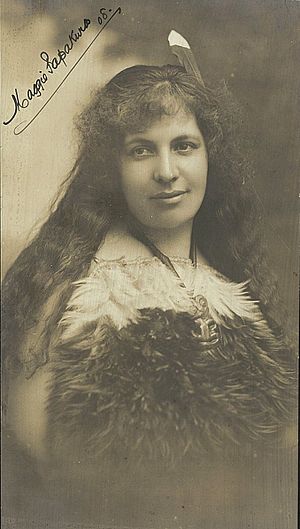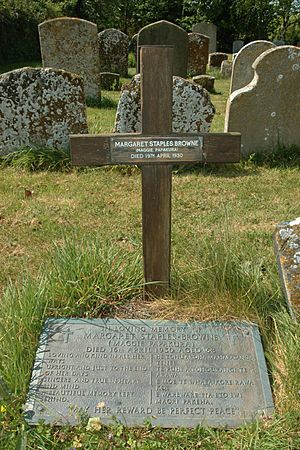Mākereti Papakura facts for kids
Maggie Papakura (also known as Mākereti Papakura), born Margaret Pattison Thom, was an important New Zealander. She lived from 1873 to 1930. Maggie was famous as a guide, an entertainer, and a writer who studied different cultures (an ethnographer). She had both Pākehā (European) and Māori family. Her Māori family belonged to the Te Arawa and Tūhourangi iwi (tribes).
Contents
Maggie's Early Life
Maggie Papakura was born in a place called Matatā in the Bay of Plenty, New Zealand, in 1873. Her father, William Arthur Thom, was from England. Her mother, Pia Ngarotū Te Rihi, was a high-ranking Te Arawa woman. Her mother's family, the Ngāti Wāhiao hapu (a smaller family group within a tribe), came from important Te Arawa chiefs.
Until she was 10, Maggie was raised by her mother's aunt and uncle. She lived in a small village called Parekārangi. There, she learned to speak the Māori language and heard many stories about her family's history and traditions. When she turned 10, her father took over her schooling. She went to schools in Rotorua and Tauranga. Later, she attended Hukarere Native School for Girls in Napier.
In 1891, when she was 18, Maggie married Francis (Frank) Dennan. He was a surveyor, which means he measured land. They had a son named William Francis (Te Aonui) Dennan that same year. The family lived in Wairarapa for a short time. But Frank left for work, and Maggie returned to Whakarewarewa. They later separated in 1900.
Maggie's Adult Life and Career
After finishing school, Maggie moved to Whakarewarewa in Rotorua. This area is famous for its hot springs and geysers. She started training to be a guide under another famous guide, Sophia Hinerangi. With her earnings, Maggie could support her young son. One day, a visitor from overseas asked her if she had a Māori last name. Maggie looked around for an idea and saw the Papakura geyser nearby. She quickly told the visitor her name was Maggie Papakura. From then on, she used that name, and her family also started using it.
Guiding and Writing
In 1901, Maggie had a very special job. She guided the Duke and Duchess of Cornwall and York around Whakarewarewa. These important visitors later became King George V and Queen Elizabeth. The newspapers noticed Maggie, and she became quite famous. Her picture appeared in magazines, calendars, and books. Two years later, she wrote her own guide book called Maggie's Guide to the Hot Lakes. It was very popular.
Performing and Traveling
Maggie was also a talented performer. In the early 1900s, she started the Rotorua Maori Choir. In 1910, she took the choir on a tour to Sydney, Australia. The tour was a big success! Some businesspeople in Sydney asked her to put together a group to perform in London. This was for the Festival of Empire celebrations.
In April 1911, Maggie's group left for England. About 40 members of her family joined, including her sister Bella and brother Dick. A leader from the Tūhourangi tribe, Mita Taupopoki, also went with them. The group performed in famous places like Crystal Palace. They also showed Māori artefacts, like a meeting house. The tour brought a lot of positive attention to Māori culture. However, the group faced money problems. About half the group decided to stay in England, and four women married Englishmen. The rest of the group returned to New Zealand in late 1911.
Maggie stayed in New Zealand only for a short time. She then went back to England. She had met Richard Staples-Browne in 1907 when he visited New Zealand. They continued their relationship and married in 1912. They lived in his country home in Oxfordshire, England.
Later Studies and Legacy
During World War I, Maggie and her husband helped injured New Zealand soldiers. They opened their homes in Oxfordshire and London to them. Maggie also put up a memorial for fallen Australian and New Zealand Army Corps (ANZAC) soldiers at a chapel.
In 1924, Maggie moved to Oxford and began studying at Oxford University. She was studying for a science degree in anthropology. Anthropology is the study of human societies and cultures. She wrote a special paper (a thesis) about Māori culture. Before handing it in, she took it to the elders in Whakarewarewa for their approval. Maggie died suddenly on April 16, 1930, at age 56. This was just three weeks before she was supposed to take her final exam. She was buried in Oddington cemetery, as she wished. Her family in Whakarewarewa built a memorial for her the next year.
Maggie's Lasting Impact
Maggie's important paper was published after her death in 1938. It was called The Old-Time Maori. This book described and explained the customs of the Te Arawa people. It was special because it showed things from a woman's point of view. It talked about daily life, like raising children and family relationships. These were topics that male writers had often ignored. Maggie also corrected mistakes made by Pakeha (European) writers who studied Māori culture. Her book was the first major published work about Māori culture written by a Māori scholar. It was reprinted in 1986.
In 1993, some of Maggie's works were part of an exhibition at Te Papa, New Zealand's national museum. In 2007, a book about her life was published by Paul Diamond. It was called Makereti: Taking Maori to the World. She was also featured in an exhibition at the National Library of New Zealand.
Maggie's house, named Tuhoromatakaka, still stands in Whakarewarewa village. It was built by a famous carver named Tene Waitere. In 2017, Maggie Papakura was recognized by the Royal Society Te Apārangi. She was chosen as one of "150 women in 150 words" for her important contributions to knowledge in New Zealand.



